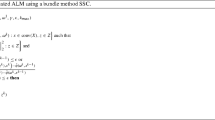Abstract
In this note, we derive the complete recursive structure of the Birge and Qi factorization for interior point methods (IPM) for tree structured linear programs as they appear in multistage stochastic programs. This recursive structure allows for an elegant implementation on parallel hardware, since multiple versions of the same program may be run on on different processors. Our preliminary computational experiment, conducted on a Beowulf cluster, demonstrates the scalability of this approach.
Similar content being viewed by others
References
J.R. Birge and D.F. Holmes, “Efficient solution of two-stage stochastic linear programs using interior point methods,” Comput. Optim. Appl., vol. 1, pp. 245-276, 1992.
J.R. Birge and L. Qi, “Computing block-angular Karmarkar projections with applications to stochastic programming,” Management Sci., vol. 34, pp. 1472-1479, 1988.
L.S. Blackford and J. Dongarra, LAPACK Working Note 81, revised version 3.0, June 1999.
M. Fiedler, Special Matrices and their Application in Numerical Mathematics, SNTL: Praha, 1981.
G.H. Golub and C.F. Van Loan, Matrix Computations, The Johns Hopkins University Press, 1996.
E.R. Jessup, D. Yang, and S.A. Zenios, “Parallel factorization of structured matrices arising in stochastic programming,” SIAM J. Optimization, vol. 4, no. 4, pp. 833-846, 1994.
S. Mehrotra, “On the implementation of a primal-dual interior point method,” SIAM J. Optimization, vol. 2, no. 4, pp. 575-601, 1992.
J. Misra, “Powerlist: A structure for parallel recursion,” TOPLAS, vol. 16, no. 6, pp. 1737-1767, 1994.
Object Management Group, OMG Unified Modeling Language (UML), version 1.4, September 2001.
G. Pflug and L. Halada, “On the Birge and Qi method for three-stage stochastic programs using IPM,” Technical Report, AURORA TR2001-12, Special Research Program SFB F011 “AURORA,” Vienna, Austria, 2001.
G. Pflug and A. Swietanowski, “Selected parallel optimization methods for finacnial management under uncertainty,” Parallel Computing, vol. 26, pp. 3-25, 2000.
A. Ralston, A First Course in Numerical Analysis, McGraw-Hill: New York, 1965.
E. Schweitzer, “An interior random vector algorithm for multistage stochastic linear programs,” SIAM J. Optim., vol. 8, no. 4, pp. 956-972, 1998.
M. Steinbach, “Tree-sparse convex programs,” Stochastic Programming Electronic Publication Series, no. 10, 2001.
H. Vladimirou and S.A. Zenios, “Scalable parallel computations for large-scale stochastic programming,” Annals Oper. Res., vol. 90, pp. 87-129, 1999.
S.J. Wright, Primal-Dual Interior Point Methods, SIAM: Philadelphia, 1997.
Author information
Authors and Affiliations
Rights and permissions
About this article
Cite this article
Pflug, G.C., Halada, L. A Note on the Recursive and Parallel Structure of the Birge and Qi Factorization for Tree Structured Linear Programs. Computational Optimization and Applications 24, 251–265 (2003). https://doi.org/10.1023/A:1021810125060
Issue Date:
DOI: https://doi.org/10.1023/A:1021810125060




